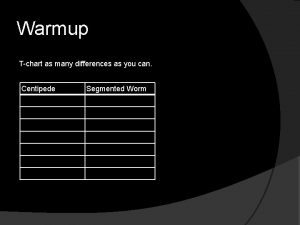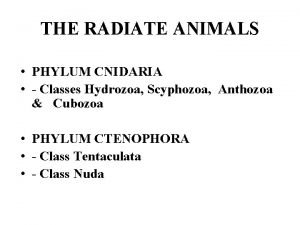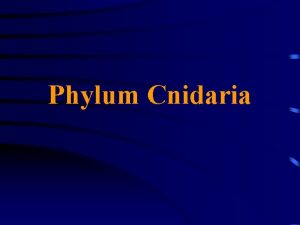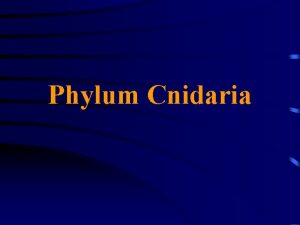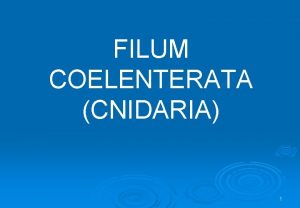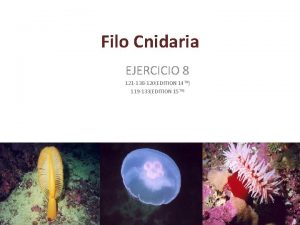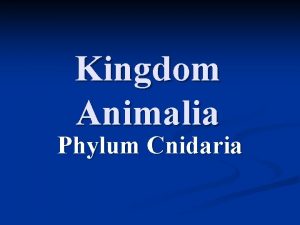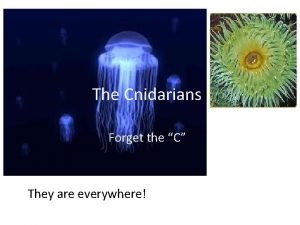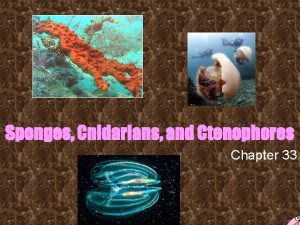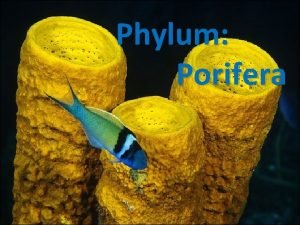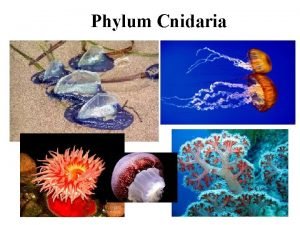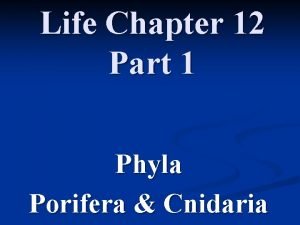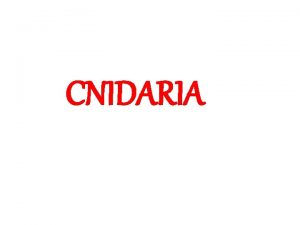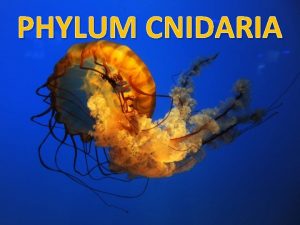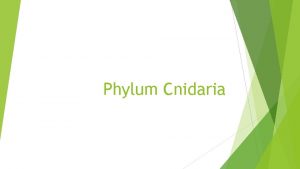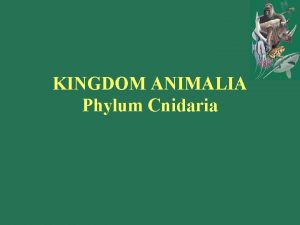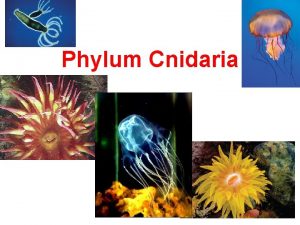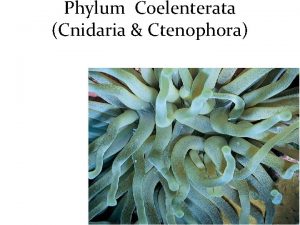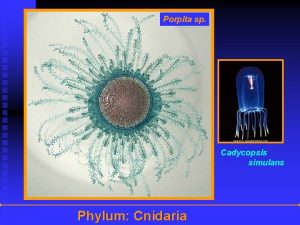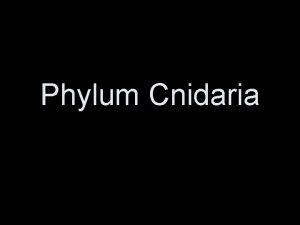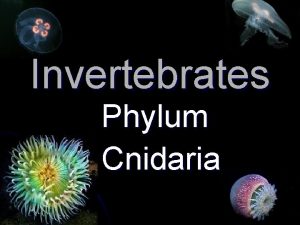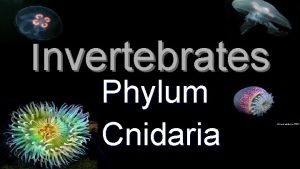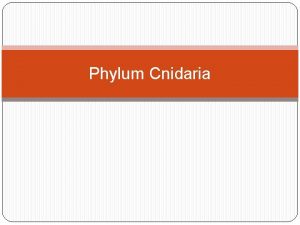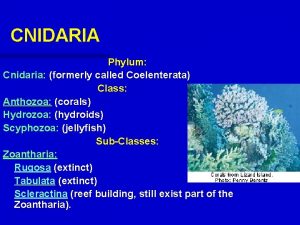Phylum Porifora Phylum Cnidaria Chapter 9 Notes Phylum















- Slides: 15

Phylum Porifora & Phylum Cnidaria Chapter 9 Notes

Phylum Porifora • Sponges - porifora = “bears pores” • Habitat: Mostly Marine • Sessile (cannot move) • Sexual or Asexual – Monoecious – both sexes in the same individual – Asexual gemmules – released when parent dies in winter – Asexual regeneration • Filter feeders – Eat particles

Phylum Porifora • Loosely organized cells No tissues or organs • Evolutionarily, most primitive animals • ~9, 000 species • Size from <1 cm - 2 m • Asymmetrical/ superficially radially symmetrical • Central cavity & branching chambers – Used to circulate water

Phylum Porifera • 3 Types of Cells – Pinacocytes “pea-knock-o-cytes” • Thin, flat cells • Line outer surface of sponge • Porocytes – regulate water circulation – Mesenchyme cells • • • “Amoeboid cells” Middle, jellylike layer Reproductive cells Secrete skeletal elements Transport and store food – Choanocytes “funnel - cell” • • Inner layer “collar cells” – ring of cells with microvilli surrounding a flagellum Flagellated Creates water currents through the sponge

Phylum Porifora • Sponges skeleton – Spicules - Microscopic needlelike spikes – Spongin – fibrous protein made of collagen

Important Groups of Porifora • Calcarious Sponges – Spicules made of calcium carbonate – Spicules are needle shaped – All marine • Glass Sponges – Spicules made of silica • Bath Sponges – Colorful sponges – Siliceous spicules or spongin or both – 1 family of freshwater sponges

Phylum Cnidaria

Phylum Cnidaria Number of Species • 9, 000+ Species Habitat • All aquatic • Mostly Marine Food Source • Small crustaceans & fish

Phylum Cnidaria Unique Characteristics: • Important in coral reef ecosystems • Have specialized cells ‘cnidocytes’ – Epidermal/gastrodermal cells – Used in defense, feeding, and attachment • Produce cnidae – a fluid-filled, intracellular capsule enclosing a coiled, hollow tube – Ex: Nematocysts (a type of cnidae) – Contain barbs to penetrate prey

Phylum Cnidaria Important groups: • Jellyfish • Anemones • Corals

Phylum Cnidaria Body Structure • Radial or biradial symmetry (oral/aboral) • Have tissues! (…and I don’t mean kleenex…) • Diploblastic (endoderm + ectoderm +mesoglea) • Specialized cells – – – Food gathering Defense Digestion Absorption • Medusa (dioecious & free swimming) or polyp (sessile & asexual) Skeletal Support • Hydrostatic skeleton – water-filled gastrovascular cavity

Phylum Cnidaria Digestion/Food Capture: • Nematocysts – entangle and paralyze prey • Tentacles contract to bring food to the mouth • Enzymes and lysosomes break down the food in gastrovascular cavity • Makes a sort of soupy mixture • Phagocytosis

Phylum Cnidaria Muscular Movement: • Pulsate muscles to move tentacles in an inchworm fashion and glide • Nutritive muscular cells move materials in and out of the gastrovascular cavity Nervous Communication: • Primitive nerve net – does not lead to anything

Excretory Waste Removal & Respiration • Both processes occur in the gastrovascular cavity • Cnidarians have a large surface-area-tovolume ratio – All cells are near body surface – O 2, CO 2, and nitrogenous wastes exchange by diffusion

Reproduction • Mostly dioecious • Sperm & egg released from gastrovacular cavity – Planula = ciliated, free-swimming larva forms polyp – Polyps reproduce by budding forms medusa • Alternation of generations life cycle
 Porifora
Porifora Life cycle of obelia
Life cycle of obelia Phylum cnideria
Phylum cnideria Phylum cnidaria general characteristics
Phylum cnidaria general characteristics Cnidaria
Cnidaria General characteristics of cnidaria
General characteristics of cnidaria Class of phylum coelenterata
Class of phylum coelenterata Phylum cnidaria classification
Phylum cnidaria classification Hydra sea anemone
Hydra sea anemone Kingdom animalia phylum cnidaria
Kingdom animalia phylum cnidaria Cube wisc
Cube wisc Cnidaria tissue layers
Cnidaria tissue layers Section 33-1 review porifera answer key
Section 33-1 review porifera answer key Porifera
Porifera 2 body forms of cnidarians
2 body forms of cnidarians Sponge type of symmetry
Sponge type of symmetry
